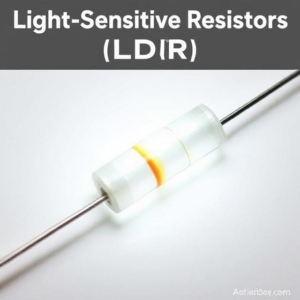Light-Sensitive Resistors (LDR) – Explained Simply
A Light-Sensitive Resistor (LDR), also known as a Photoresistor, is a special type of resistor that changes its resistance based on the amount of light it receives. It’s like a “smart” resistor that reacts to light.

1. What is an LDR?
An LDR is a type of resistor made from semiconductor materials (usually cadmium sulfide, or CdS) that has a special property: its resistance decreases when light hits it and increases when it’s dark.
- In the dark, the LDR has high resistance (meaning it doesn’t allow much current to flow through it).
- In the light, the LDR has low resistance (meaning it allows more current to flow through it).
2. How Does an LDR Work?
When light hits the LDR, it excites the electrons inside the material. This causes the material to conduct electricity more easily, reducing its resistance.
- In darkness: The LDR doesn’t have much energy, so it resists the flow of electricity, like a blocked pipe.
- In bright light: The light excites the LDR, making it easier for electricity to flow, like opening the pipe and letting the current flow smoothly.
3. Basic Structure of an LDR:
An LDR typically has a simple structure:
- It is usually a small, flat component with two terminals (legs) on each side.
- The surface of the LDR is sensitive to light, so it’s usually made from a material that can absorb light and change its conductivity.
4. Applications of LDRs:
LDRs are used in many devices where you want to control or measure light. Some common uses include:
- Automatic Street Lights: LDRs can detect when it gets dark and automatically turn on the streetlights.
- Light Meters: Cameras and other devices use LDRs to measure the intensity of light.
- Brightness Control in Devices: LDRs can be used to adjust the brightness of a display based on the surrounding light (like in smartphones or TVs).
- Alarm Systems: LDRs can detect changes in light, which is useful in motion sensors and security systems.
5. Example:
Imagine you have a circuit with an LDR and a battery:
- When there’s no light (dark), the LDR’s resistance is very high, and only a small current can flow.
- When there’s bright light, the LDR’s resistance decreases, allowing a larger current to flow through the circuit.
6. Advantages of LDRs:
- Simple to use and inexpensive.
- Automatically adjusts to light conditions, making them great for automatic systems.
- Can be used to measure light intensity in different environments.
7. Limitations of LDRs:
- Slow response: LDRs can take a little time to react to changes in light.
- Temperature sensitivity: Their resistance can be affected by temperature changes.
- Not very precise: LDRs don’t provide very detailed information about light intensity (they are more of a general indicator).
8. Summary:
A Light-Sensitive Resistor (LDR) is a type of resistor that changes its resistance depending on how much light it gets. It allows more current to flow when it’s exposed to light and less current when it’s dark. LDRs are commonly used in light-sensitive applications like street lights, automatic brightness control, and light meters.
Tags: ambient light sensor, automatic lighting, automatic street lights, brightness control, cadmium sulfide (CdS), Electronic Circuit, electronic component, electronic resistors, high resistance in dark, LDR, light control devices, light detection, light intensity measurement, light meters, light sensor, light-dependent resistor, light-responsive resistor, Light-sensitive resistor, low resistance in light, low-cost sensor, motion sensors, photoresistor, resistance changes with light, Resistors, Security Systems, semiconductor resistor, sensor applications, slow response sensor, temperature sensitivity


